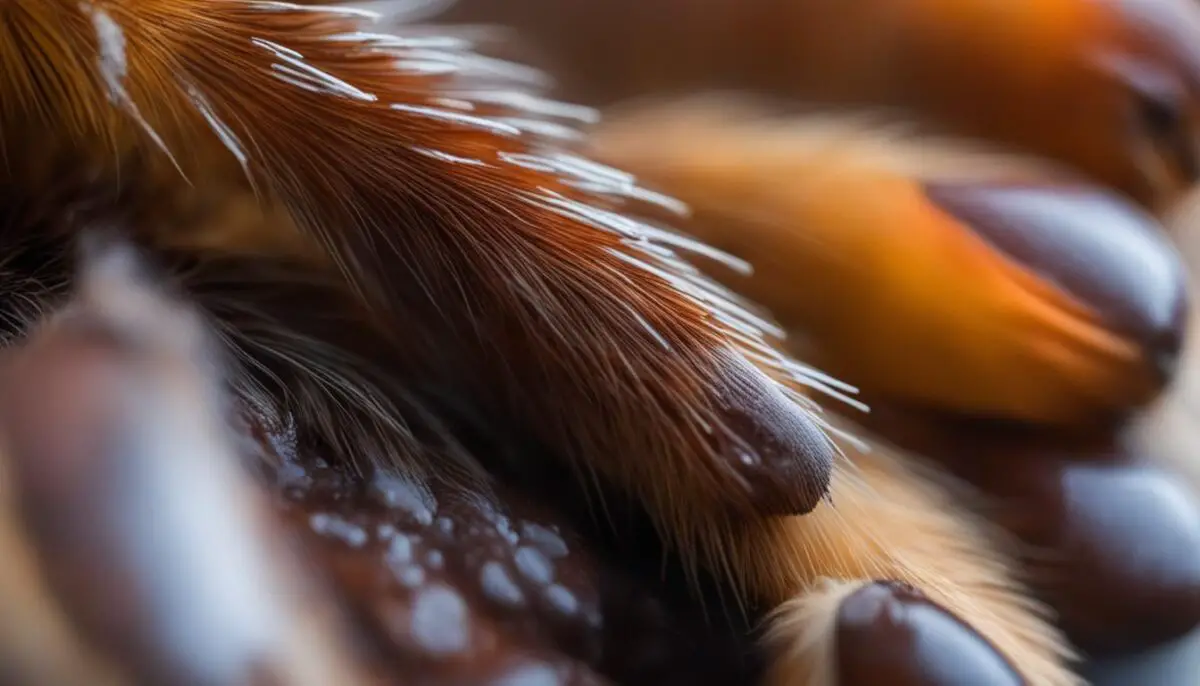When a dog is stung by hornets, it can be a painful and frightening experience. Hornets, bees, and other stinging insects can cause mild irritation or even severe allergic reactions in dogs. Prompt action is necessary to provide relief and minimize the risk of complications. Here are some quick relief tips if your dog gets stung by hornets.
Key Takeaways:
- Act quickly to identify and treat the sting.
- Apply a paste of baking soda and water to soothe the bite site.
- Minimize swelling by applying an ice pack for 10 minutes.
- Consider giving your dog an oral antihistamine to reduce allergic reactions and itching.
- Seek veterinary care if symptoms worsen or if your dog shows signs of a severe allergic reaction.
Identifying and Treating the Sting
If you suspect that your dog has been stung by a hornet, it’s important to act quickly. First, identify the insect if possible and remove the stinger if it’s a honeybee. Then, soothe the bite site by applying a paste of baking soda and water. Minimize swelling by applying an ice pack for 10 minutes. You can also give your dog an oral antihistamine to reduce the allergic reaction and itching. It’s crucial to prevent excessive scratching, maintain hydration and food intake, and seek veterinary care if the symptoms worsen or if your dog shows signs of a severe allergic reaction.

Soothing the Bite Site
One of the first steps in treating a hornet sting in dogs is to soothe the bite site. By creating a paste of baking soda and water, you can help alleviate the discomfort and reduce swelling. Apply the paste directly onto the sting and let it sit for a few minutes before gently wiping it off.
Reducing Swelling
Applying an ice pack to the sting site can help reduce swelling and provide relief. Wrap the ice pack in a clean towel and hold it against the affected area for 10 minutes. This can help minimize the inflammation and discomfort caused by the hornet sting.
Managing Allergic Reactions
If your dog shows signs of an allergic reaction, such as excessive itching, redness, or difficulty breathing, it’s important to take immediate action. Administering an oral antihistamine can help reduce the allergic response and provide relief. However, it’s essential to consult your veterinarian before giving any medication to your dog, as dosages may vary depending on their size and condition.
Preventing Complications
To prevent complications from a hornet sting, it’s crucial to prevent excessive scratching. Use an Elizabethan collar, also known as a cone, to prevent your dog from reaching the affected area. Additionally, make sure your dog stays hydrated by providing plenty of fresh water. Encourage them to eat their regular meals, as proper nutrition can aid in the healing process.
Seeking Veterinary Care
If your dog’s symptoms worsen or if they show signs of a severe allergic reaction, such as swelling around the face or difficulty breathing, it’s important to seek immediate veterinary care. A veterinarian can assess your dog’s condition, provide appropriate treatment, and ensure their well-being.
Recognizing Severe Reactions
While most hornet stings cause mild to moderate reactions in dogs, some dogs may have severe allergic reactions. It’s important to be aware of the symptoms of a severe reaction, which can include:
- Severe swelling around the head and neck
- Hives on any part of the body
- Difficulty breathing or wheezing
- Excessive drooling
- Agitation
- Vomiting or diarrhea
- Dizziness or disorientation
- Seizures
If your dog experiences any of these symptoms, it’s crucial to seek immediate veterinary care as these reactions can be life-threatening.

Emergency Care for Severe Reactions
If your dog shows signs of a severe allergic reaction or anaphylactic shock, it’s important to provide immediate emergency care. The first step is to assess the situation and ensure your dog’s safety. Remove your dog from the area where they were stung to minimize the risk of additional stings. Then, carefully observe your dog’s symptoms and behavior.
If the symptoms are severe and your dog is experiencing difficulty breathing, wheezing, or swelling around the head and neck, it’s crucial to act quickly. Contact your veterinarian or the nearest emergency veterinary clinic for guidance and inform them about the situation. While awaiting professional help, there are a few steps you can take to provide initial care:
- Stay calm and reassure your dog. Your presence can help alleviate their anxiety.
- Administer prescribed oral antihistamines, corticosteroids, or epinephrine, if directed by your veterinarian. Some dogs may have pre-existing medical conditions that require customized treatment protocols, so it’s essential to follow your vet’s recommendations.
- If your dog is conscious, try to keep them calm and prevent excessive movement. Keep them in a quiet, comfortable area to reduce stress.
- Apply a cold compress or ice pack wrapped in a cloth to the sting area to help alleviate pain and reduce swelling. Avoid placing ice directly on the skin as it may cause frostbite.
- Do not attempt to administer any medication or interventions without professional guidance, as some medications can be harmful to dogs and may worsen the situation.
Once you have contacted your veterinarian or arrived at the emergency veterinary clinic, they will assess your dog’s condition and determine the necessary course of action. Treatment may involve:
- Administration of intravenous fluids to maintain hydration and stabilize your dog’s blood pressure.
- Oxygen support, if necessary, to assist with breathing and ensure adequate oxygenation.
- Monitoring your dog’s organ function through additional tests such as blood work, x-rays, or ultrasound.
- In severe cases, hospitalization may be required to closely monitor your dog’s response to treatment and provide ongoing care.
It’s important to note that the length of the hospital stay will vary depending on your dog’s response to treatment and the severity of the reaction. Your veterinarian may also prescribe an Epi-Pen for future insect stings, ensuring that you are prepared to provide immediate care in case of future emergencies.
Remember, always consult with your veterinarian for specific advice and guidance tailored to your dog’s individual needs. Prompt and appropriate emergency care can help save your dog’s life and prevent complications from severe allergic reactions to hornet stings.
Case Study: Ollie’s Emergency Care Journey
Preventing Hornet Stings
Prevention is key when it comes to protecting your dog from hornet stings. By taking a few precautionary measures, you can significantly reduce the risk of your furry friend getting stung. Here are some tips to keep your dog safe:
- Be aware of your dog’s surroundings and avoid areas where hornets are actively present.
- During outdoor activities, keep your dog away from beehives, wasp nests, and hornet nests.
- If you’re planning to visit an area known for hornets, consider using insect repellents designed for dogs or dressing your dog in protective clothing.
- Regular grooming is important to keep your dog’s coat clean and free from pests. This allows you to closely monitor your dog for any signs of stings.
By following these preventive measures, you can enjoy outdoor activities with your dog while minimizing the risk of hornet stings. Remember, prevention is always better than treatment!
| Preventive Measures | Benefits |
|---|---|
| Avoiding areas with hornets | Reduces the chances of your dog encountering hornets and getting stung |
| Keeping your dog away from beehives, wasp nests, and hornet nests | Minimizes the risk of accidental stings and potential aggressive behavior from hornets |
| Using insect repellents or protective clothing | Adds an extra layer of defense against hornets and reduces the likelihood of stings |
| Regular grooming and monitoring | Allows you to detect and treat any stings promptly, preventing complications |
Remember, even with preventive measures in place, accidents can happen. If your dog does get stung by a hornet, refer to the previous sections for quick relief tips, identifying and treating the sting, recognizing severe reactions, and providing emergency care when needed.
Conclusion
When your dog is stung by hornets, it’s crucial to act swiftly and effectively. By promptly identifying and treating the sting, recognizing severe reactions, providing emergency care when necessary, and implementing preventive measures, you can ensure your dog finds quick relief and minimize the risk of complications. Remember to consult with your veterinarian for personalized guidance based on your dog’s unique needs.
By identifying the insect, removing the stinger (if it’s a honeybee), applying a soothing baking soda paste, and administering an oral antihistamine, you can alleviate discomfort and reduce allergic reactions. Recognizing severe allergic reactions, such as swelling, difficulty breathing, or seizures, requires immediate veterinary attention to prevent life-threatening situations.
In cases of severe reactions or anaphylactic shock, emergency care is crucial. Administering medications as directed by your veterinarian, providing intravenous fluids and oxygen support, and monitoring organ function are essential for your dog’s recovery. Finally, taking preventive measures like avoiding areas with hornets, using insect repellents, and regular grooming can significantly reduce the risk of hornet stings.
By following these steps and consulting with your veterinarian, you can ensure the well-being of your furry friend and handle hornet stings effectively. Remember, being prepared and taking quick action can make all the difference when it comes to providing relief and protecting your dog from potential complications. Act now to keep your dog safe and healthy.
FAQ
What should I do if my dog is stung by a hornet?
If your dog is stung by a hornet, act quickly. Remove the stinger if it’s a honeybee and soothe the bite site with a baking soda and water paste. Apply an ice pack to minimize swelling and give your dog an oral antihistamine. If symptoms worsen, seek veterinary care.
What are the symptoms of a severe allergic reaction to a hornet sting?
Symptoms of a severe allergic reaction can include severe swelling around the head and neck, hives on any part of the body, difficulty breathing, excessive drooling, vomiting or diarrhea, dizziness or disorientation, and seizures.
How can I provide emergency care for my dog if it has a severe allergic reaction to a hornet sting?
If your dog shows signs of a severe allergic reaction, seek immediate veterinary care. Administer oral antihistamines, corticosteroids, or epinephrine as directed by your veterinarian. Your dog may also require intravenous fluids, oxygen support, and additional tests.
How can I prevent my dog from getting stung by hornets?
To prevent hornet stings, be cautious during outdoor activities and avoid areas with active hornet nests. Consider using insect repellents or protective clothing for your dog in known hornet areas. Regular grooming and monitoring can also help prevent complications.
What should I do to provide quick relief for my dog if it gets stung by hornets?
Promptly identify and treat the sting. Remove the stinger if it’s a honeybee, apply a baking soda and water paste, and use an ice pack to reduce swelling. Give an oral antihistamine. Consult with your veterinarian for specific advice tailored to your dog’s needs.

